
Two Chinese craft brewers are hoping the popular appeal of pandas - and some of China's distinctive flavors - will be a hit in other countries, Liu Zhihua reports.
The giant panda, the beloved emblem of China, now also bears two young Chinese men's dream to take the country's distinctive flavors to craft-beer lovers around the world.
The Chinese brand Panda Brew, co-founded by Xia Yulin, Pan Dinghao and a former partner in early 2013, has just released its newest craft beer, Kuding Pale Ale, at its flagship pub in Beijing.
|
The bittersweet fragrance of kuding echoes the Chinese proverb, "sweetness comes after bitterness". Photos by Bruno Maestrini / China Daily |
|
Pan Dinghao says the range of Panda Brew flavors offers something for both Chinese and foreign drinkers. |
"The panda is the most recognizable emblem of China, and Pan chose it for our brand name because he hopes one day we will sell our craft beer to Canada, where he learned about craft beer," Xia says, adding that Pan used to study automotive engineering in Canada.
The team's new brew uses the leaf of broadleaf holly - the widely used traditional Chinese herb kuding - to enhance the taste and function. As medicine, it's credited with boosting eyesight and intelligence, and is also widely used in China by those seeking to quench thirst, lose weight, reduce high blood pressure, and slow aging.
The two entrepreneurs went to Fujian province, where the best broadleaf holly is said to grow in China, and ultimately selected a sub-species that is not too bitter as an additive for the new beer.
Pan says it took quite a few experiments to figure out when and how to use the bitter leaves during brewing. The resulting beverage has a bittersweet fragrance and a mild, sweet aftertaste that lingers after a sip. Pan says that echoes a Chinese proverb, "sweetness comes after bitterness".
Xia says the taste is just like life.
Kuding Pale Ale has a relatively high alcohol percentage, ranging between 6.5 and 6.9 percent.
Pan and Xia fell in love with craft beers during their school years, respectively in Canada from 2005 to 2010 and the United Kingdom from 2002 to 2003. They met in 2011, and, together with a third partner who has since quit, they decided to build their own brewery and brand when they found the supply of quality craft beer fell short of the demand on the Chinese mainland.
They started a tiny home-brew store of less than 20 square meters in February 2013, using yeast they managed to import from abroad.
Their nine kinds of beers soon became a hit among craft beer lovers in the capital area, and they could afford to open a 200-square-meter pub at the end of 2014.
They also tried bottling their beer to sell it beyond the Beijing area, starting in October 2013. Soon Panda Brew was on sale in bars, cafes and restaurants in 31 cities across China, including Shanghai, Hangzhou in Zhejiang province and Guangzhou in Guangdong province.
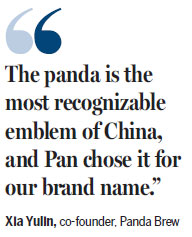
Their first bottled beer was Pure Red Honey Ale, which is the most popular variety in the pub, and is an adaptation of the famous White House Honey Ale.
That ale was first brewed at President Barack Obama's request in 2011, using honey from hives on the White House lawn. The beer generated lots of online buzz after being served at parties for the Super Bowl and St Patrick's Day, and the White House blog released the recipe in September 2012, intriguing people around the world to make the brew. It is also available as a beer-making kit online.
Xia says Panda Brew revised the recipe to make the honey aroma stronger, and the flavor less layered, as well as to increase the sweetness, to appeal to Chinese drinkers.
The honey used in the brewing was from high mountains in Hunan province, where Pan and Xia spent months looking for the organic honey made by a bee species that is indigenous to China.
The honey is called baihua honey, or 100-flower honey. Nobody really counts the flowers - it just means "honey from a lot of flowers", Pan says, adding that the honey is believed to aid digestion and stomach health.
Xia notes the beekeepers who supply their honey have been in the business for four generations.
The brew looks red as the color is considered good in China and Panda Brew manages to achieve that without using chemical agents, Pan says.
The founders, who began home-brewing beer in simple cookware before their professional expansion, soon plan to brew new types with other Chinese fruits and herbs soon, to highlight even more Chinese flavors in the world of craft beers.
Contact the writer at liuzhihua@chinadaily.com.cn
(China Daily 06/16/2015 page19)

China's top 10 foodie cities |
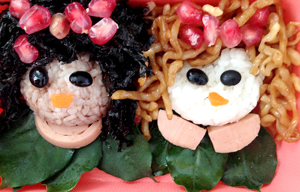
Cute boxed meals |
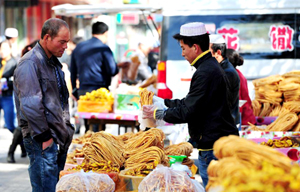
Muslims greet annual festival of Eid al-Adha in Yinchuan |
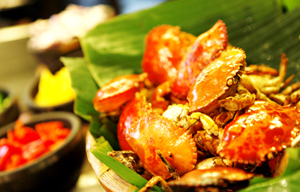
Cafe Noir hosts Singapore food festival |

Top 10 catering brands in China |

Watermelon toast gains popularity in Taiwan |
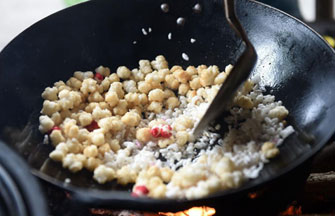
Tradition of drinking oleic tea in Guangxi |
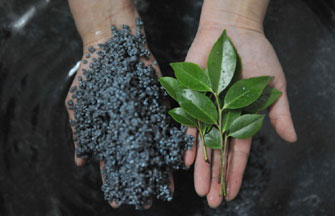
Black rice treats in summertime |